Genus Camponotus subgenus Myrmotrema
| The Ants of
Africa Genus Camponotus subgenus Myrmotrema |
|
| Genus Camponotus |
Subgenus definition - Section 11 Myrmotrema Forel (1912i: 91) - simply had - "group foraminosus and relatives; characterised by the foraminous or carious head of both major and minor".
![]() Head as in Orthonotomyrmex,
major very broad posteriorly,
minor trapezoidal, broadened posteriorly; thorax with or without dorsal
notch; in major and queen anterior of head covered with deep round
pits; apparently termitophages, 32 species from sub-Saharan Africa.
Head as in Orthonotomyrmex,
major very broad posteriorly,
minor trapezoidal, broadened posteriorly; thorax with or without dorsal
notch; in major and queen anterior of head covered with deep round
pits; apparently termitophages, 32 species from sub-Saharan Africa.
Primarily based on my translation of the work of Santschi (1915c), the Key surely is out of date, especially for eastern/southern Africa, but it still has obvious relevance. I have used modern nomenclature (as in Bolton, 1995), added the species argus and made comments.
Bernard (1952) gave the definition "Section 11 Myrmotrema Forel - small to medium sized, gaster matt, with or without dense coloured hairs, antenna more or less deformed, apparently termitophages, 32 species from sub-Saharan Africa". Bolton (1995) also has 32 names of species in the subgenus.
Of his Key, Santschi noted - there is insufficient material to establish purely phylogenetic characters so I have used practical features.
Provisionally, he recognized five species within the foraminosus group, with more or less cylindrical tibiae and without a row of "piquants" = spike-like hairs?:
Species post-dating the Santschi key are -
avius
from Zimbabwe & Angola
monardi
from Angola - close to grandidieri
and tilhoi
from Chad - seemingly close to olivieri.
Key to members of the subgenus Myrmotrema
| 1 | Tibiae cylindrical or not strongly compressed, without a line of spurs; scapes cylindrical or slightly flattened | 2 |
| -- | Tibiae prismatic or generally channelled; scapes always flattened; all are black | 42 |
| 2 | Head and alitrunk always black | 3 |
| -- | Head and alitrunk otherwise coloured | 36 |
| 3 | 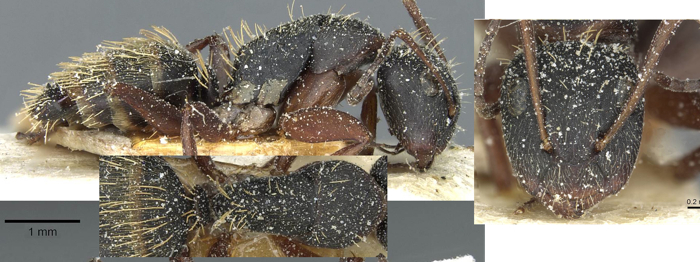 TL 5-8
mm; gaster segments largely bordered with yellow; long golden
pubescence and abundant, slender, very long, yellow silky hairs TL 5-8
mm; gaster segments largely bordered with yellow; long golden
pubescence and abundant, slender, very long, yellow silky hairs |
Saõ Thomé - aurofasciatus |
| -- | Gaster black or brown black or very narrowly bordered with yellow; silky hairs shorter | 4 |
| 4 | Propodeum with dorsum very compressed so comprising little more than the declivity | 4A |
| -- | Propodeum dorsum not compressed | 5 |
| 4A | Worker only known TL 4.5 mm | Zaïre - argus |
| -- |  TL 9.6-11.6 mm;
pilosity whitish, thick and pointed; distinctive pattern on the gaster TL 9.6-11.6 mm;
pilosity whitish, thick and pointed; distinctive pattern on the gaster |
. |
| . | 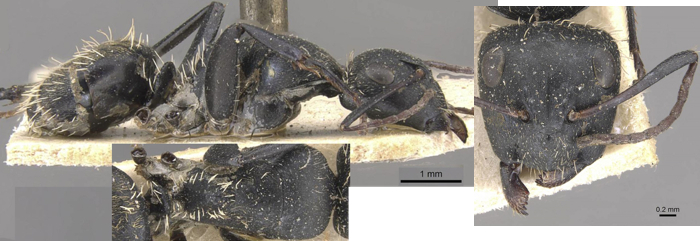 Media/minor Media/minor |
South Africa - postoculatus |
| 5 | Propodeum dorsum rectangular, slightly convex and weakly bordered | 6 |
| -- | Propodeum dorsum narrower especially posteriorly | 7 |
| - | Propodeum dorsum rectangular, slightly convex and weakly bordered | - |
| 6 | 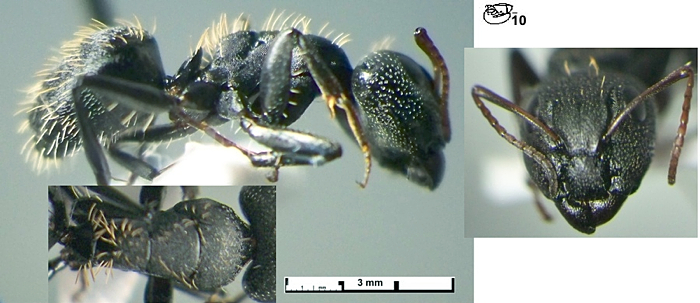 Stocky,
black, antennae red; propodeum dorsum flat; TL 5.3-6.3 mm; major not
before found is larger; the sharply angled propodeum profile is
distinctive Stocky,
black, antennae red; propodeum dorsum flat; TL 5.3-6.3 mm; major not
before found is larger; the sharply angled propodeum profile is
distinctive |
|
| . |  Minor Minor |
East Africa - galla |
| -- | 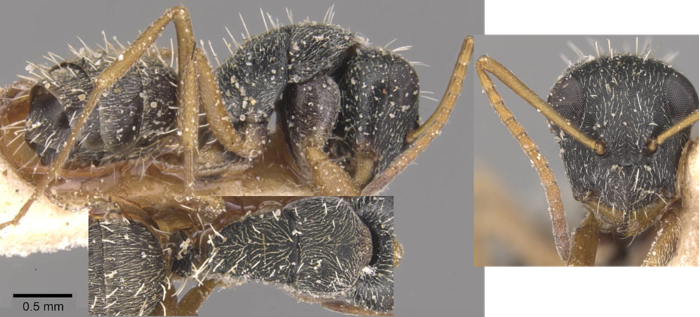 TL 3.5-6.6 mm; more
slender; matt and entirely punctate; tarsi and antennae red, posterior
borders of gaster yellow gold TL 3.5-6.6 mm; more
slender; matt and entirely punctate; tarsi and antennae red, posterior
borders of gaster yellow gold |
Guinea & Ivory Coast - orthodoxus |
| -- |  Description inadequate on structure but - erect pilosity
long yellowish but scattered, gaster with greyish moderate pubescence;
overall black; base of scape, apices of anterior and mid tarsi,
spicules and spurs reddish; TL 6.9-9.2 mm Description inadequate on structure but - erect pilosity
long yellowish but scattered, gaster with greyish moderate pubescence;
overall black; base of scape, apices of anterior and mid tarsi,
spicules and spurs reddish; TL 6.9-9.2 mm |
Malawi - lamborni |
| - | Propodeum dorsum narrow especially posteriorly | - |
| 7 | Genae of majors with confluent hair pits, which are larger than spaces between; the arising hairs long and abundant, similar to those on the gaster | 8 - auropubens and ssps |
| -- | Genae of majors with shallow hair pits that are smaller than the spaces, and with only very short or no hairs | 12 |
| 8 | Gaster with a clear median glabrous line | 9 |
| -- | Gaster with no more than a very fine glabrous line [the attribution to foraminosus seems dubious]; TL 5.0-8.7 mm | Aldabra I. - foraminosus ssp aldabrensis |
| 9 | Genae with partially raised pubescence, as long as width of scape extremity | 10 |
| -- | Genae pubescence short and decumbent | 11 |
| 10 |  Tibiae
blackish brown; propodeal dorsum slightly convex; TL to 9.0 mm Tibiae
blackish brown; propodeal dorsum slightly convex; TL to 9.0 mm |
Mozambique- auropubens |
| -- | 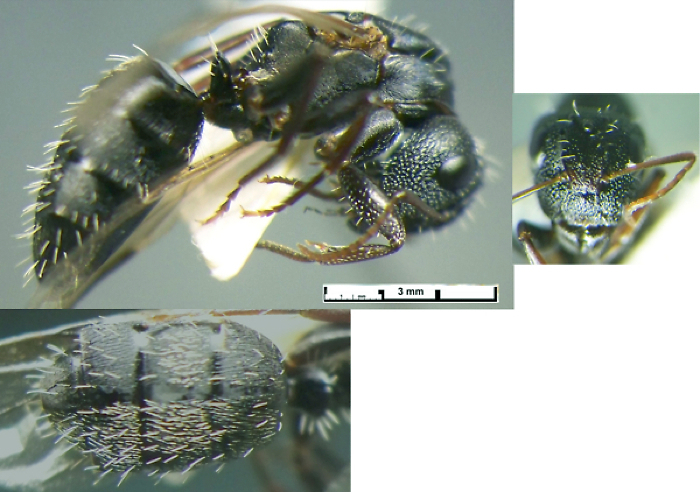 Tibiae rust; propodeal
dorsum flat; mesonotum of female matt; TL 5.5-9.5 mm Tibiae rust; propodeal
dorsum flat; mesonotum of female matt; TL 5.5-9.5 mmQueen shown |
South Africa - auropubens ssp absalon |
| 11 | 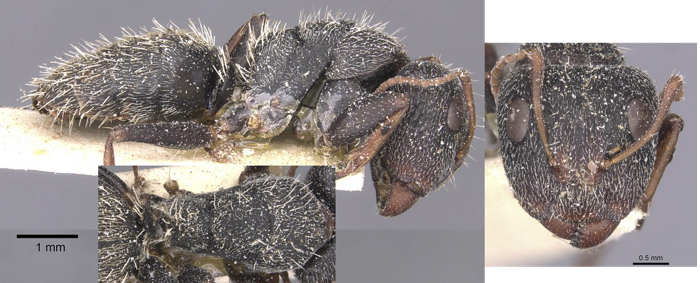 Major, pilosity
golden; tibiae rust Major, pilosity
golden; tibiae rust |
. |
| . |  Minor Minor |
south eastern Africa - auropubens ssp jacob |
| -- | Pilosity silver; female with shiny pronotum | Angola - auropubens ssp argentopubens |
| 11A | 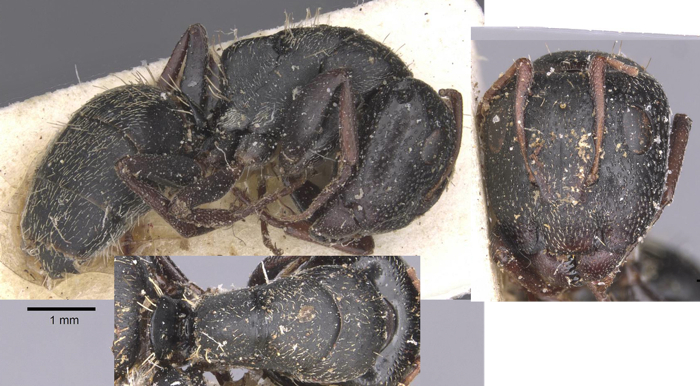 Gynandromorph major Gynandromorph major |
south eastern Africa - monardi |
| Genae of majors with shallow hair pits that are smaller than the spaces, and with only very short or no hairs | - | |
| 12 | Gaster with fine, long pubescence, generally cloaking the sculpture; without median glabrous line | 13 |
| -- | Pubescence more translucent/sparser | 18 |
| 13 | Clypeus of major without a carina; erect silky hairs fine generally same colour as pubescence | 14 - foraminosus and ssps |
| -- | 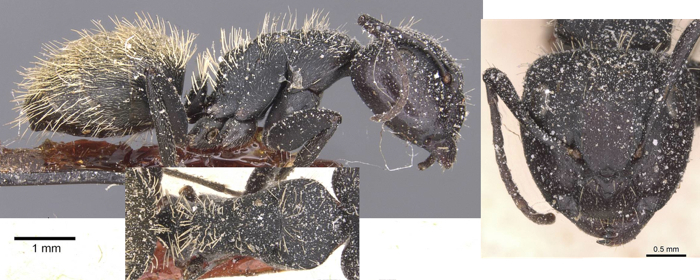 Clypeus of major with
a carina; erect silky hairs slender,
abundant clear yellow; TL 6-8.2 mm Clypeus of major with
a carina; erect silky hairs slender,
abundant clear yellow; TL 6-8.2 mm |
. |
| . |  Minor Minor |
north-east Africa west to Chad - rhamses |
| 14 | Very matt appearance; head and alitrunk glabrous | Ethiopia - foraminosus ssp honorus |
| Head and alitrunk quite pubescent | 15 | |
| 15 | Gaster with greyish yellow pubescence | 16 |
| -- | Gaster with yellow or brassy red pubescence | 17 |
| 16 |  Dorsum
of gaster with dense pubescence; TL major 7-8 mm Dorsum
of gaster with dense pubescence; TL major 7-8 mm |
. |
| . |  |
West Africa & Congo Basin - foraminosus |
| -- | Pubescence less dense | Nigeria, Calabar - foraminosus ssp deductus |
| -- |  |
Congo - foraminosus ssp flavus |
| 17 | Gaster with golden yellow pubescence | East Africa - foraminosus ssp chrysogaster |
| -- | Gaster with brassy red pubescence [in the accompanying text, Santschi had this as foraminosus var. annobonensis; if he was right it seems more likely it is a foraminosus ssp] | Annobon I. - perrisii ssp insularis |
| Pubescence more translucent/sparser | -- | |
| 18 | Gaster matt, densely puncturate; pubescence generally quite long | 19 |
| -- | Gaster shiny, or shiny matt; largely finely reticulate or shagreened; pubescence generally quite short and spaced out | 26 |
| 19 | Gaster dorsum with a median glabrous line; sometimes less obvious on smaller morphs | 20 |
| -- | Gaster dorsum without median glabrous line | 23 |
| 20 | Major with scapes not surpassing occiput by more than the length of funiculus segment 1. | 21 |
| -- | Scapes longer | 22 |
| 21 |  Tibiae and tarsi
rust coloured; pubescence distinct on
clypeus and genae; TL 5.0-8.2 mm Tibiae and tarsi
rust coloured; pubescence distinct on
clypeus and genae; TL 5.0-8.2 mm |
Madagascar - grandidieri |
| -- | Tibiae and tarsi black or black brown; gaster more elongated; glabrous line less obvious | Grand Comoro I. - grandidieri ssp comorensis |
| 22 | Tibiae and tarsi more or less rust coloured; glabrous line clear | Madagascar; Diego Suarez, Mozambique - grandidieri ssp atrabilis |
| -- | Tibiae and tarsi black; head of minors more elongated; glabrous line less obvious | South Africa - grandidieri ssp mendax |
| 23 | Propodeum dorsum triangular, very narrow posteriorly; antennae and lower legs red | 24 |
| -- | Propodeum dorsum insignificantly narrowed posteriorly | 25 |
| 24 | Propodeum dorsum slightly convex in profile; pubescence slight, as with the erect hairs | Somalia - grandidieri ssp ruspolii |
| -- | Propodeum dorsum straight-sided; pilosity and pubescence more abundant | South Africa - grandidieri ssp rollei |
| 25 | 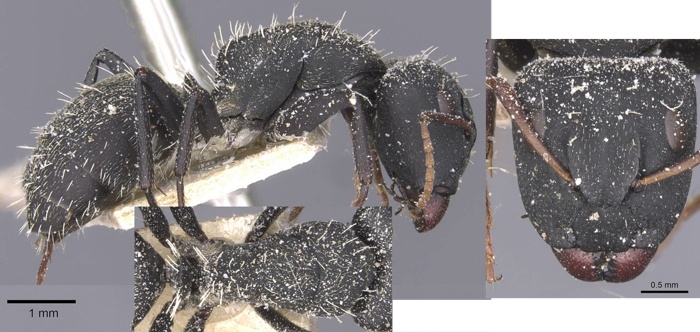 Major TL 7.5 mm; propodeal
dorsum as long as declivity; alitrunk less convex; golden pubescence
quite abundant; silky hairs slim white and blunt; very matt Major TL 7.5 mm; propodeal
dorsum as long as declivity; alitrunk less convex; golden pubescence
quite abundant; silky hairs slim white and blunt; very matt |
. |
| . | 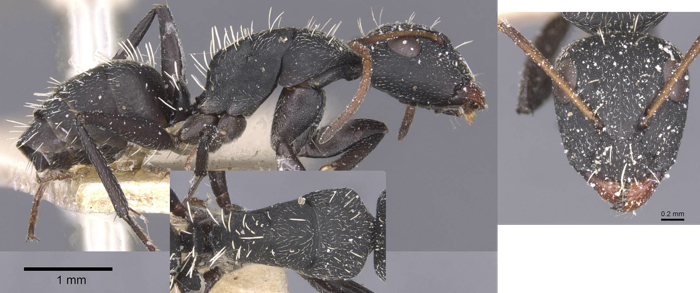 Minor TL 5.5 mm Minor TL 5.5 mm |
Angola - benguelensis |
| -- | 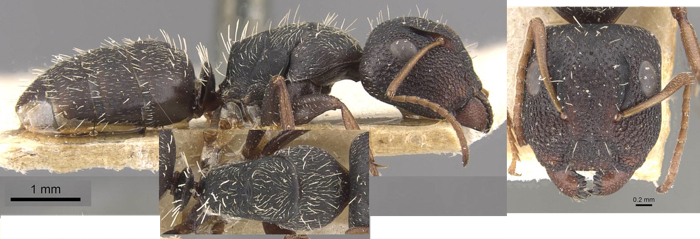 Major; TL 4.5-7 mm; clypeus
without a carina; tibiae without
setae; propodeum narrow, rectilinear in profile, dorsum slightly
shorter than declivity; erect hairs sparse whitish; pubescence on the
body bright whitish-yellow; overall matt black, mandibles, tibia &
tarsi reddish, femora brown Major; TL 4.5-7 mm; clypeus
without a carina; tibiae without
setae; propodeum narrow, rectilinear in profile, dorsum slightly
shorter than declivity; erect hairs sparse whitish; pubescence on the
body bright whitish-yellow; overall matt black, mandibles, tibia &
tarsi reddish, femora brown |
. |
| . | 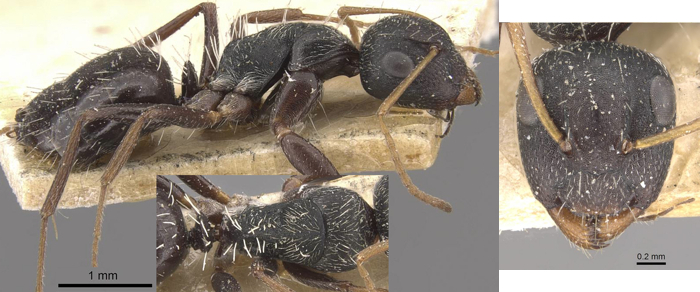 Minor Minor |
Zaire, Katanga - confluens |
| -- |  Propodeal
dorsum shorter than declivity; pubescence white, short and translucent;
silky hairs fine and quite short; semi-matt, genae shiny; TL 4.4-7.35 mm Propodeal
dorsum shorter than declivity; pubescence white, short and translucent;
silky hairs fine and quite short; semi-matt, genae shiny; TL 4.4-7.35 mm |
. |
| . |  Type Major Type Major |
. |
| . | 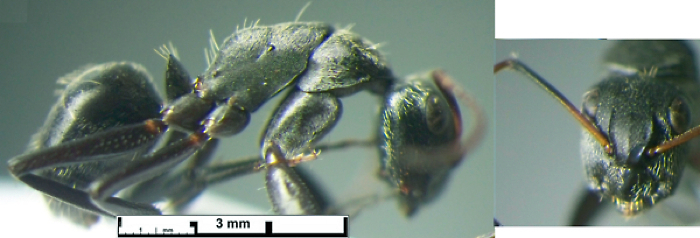 |
Nigeria - haereticus |
| Gaster shiny, or shiny matt; largely finely reticulate or shagreened; pubescence generally quite short and spaced out | -- | |
| 26 | 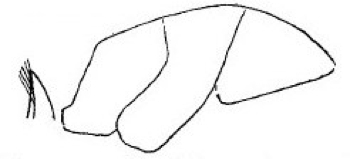 Distinct
angle at junction of dorsum and declivity of propodeum, sometimes with
rounded edge; no glabrous line on gaster Distinct
angle at junction of dorsum and declivity of propodeum, sometimes with
rounded edge; no glabrous line on gaster |
27 - olivieri and ssps. |
| -- | Junction of propodeum dorsum and declivity a rounded curve; gaster with distinct medial glabrous line | 35 |
| 27 | Scapes entirely black; TL 6.0-8.5 mm | 27A |
| -- | Erect hairs white; base of scapes and funiculus segment 1 rust coloured | 28 |
| 27A | Erect hairs and pubescence golden; TL 6.0-8.5 mm | Angola - olivieri ssp concordia |
| 27B | 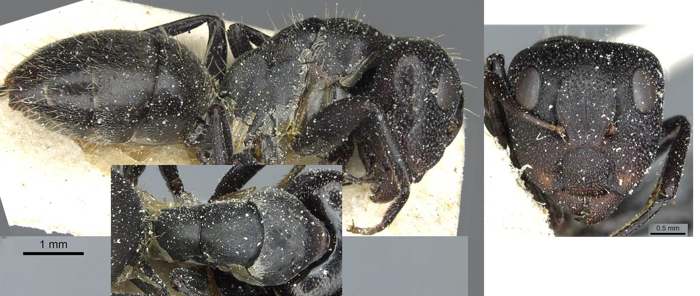 Pilosity whitish, fine
and sharp, moderately abundant; worker TL 7.5 -8.0 mm; cf olivieri alitrunk
more robust, mesonotum more raised, propodeal angle more rounded,
propodeal dorsum straight but transversely rounded, declivity concave;
overall black, scape entirely black except condyle, funiculus, condyle,
mandibles anterior of head, posterior tarsi brown; densely matt except
feebly shiny dorsal pronotum Pilosity whitish, fine
and sharp, moderately abundant; worker TL 7.5 -8.0 mm; cf olivieri alitrunk
more robust, mesonotum more raised, propodeal angle more rounded,
propodeal dorsum straight but transversely rounded, declivity concave;
overall black, scape entirely black except condyle, funiculus, condyle,
mandibles anterior of head, posterior tarsi brown; densely matt except
feebly shiny dorsal pronotumNote apparently identical to tilhoi (below) |
Zaïre - atriscapus |
| 27C | 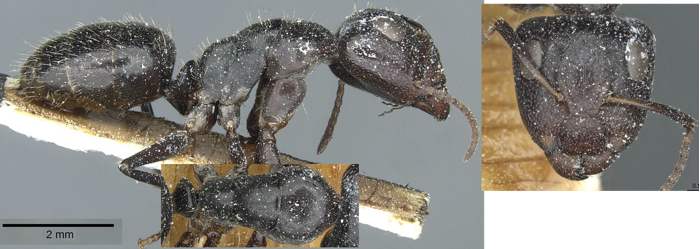 Major: Pilosity whitish, fine
and sharp, moderately abundant; worker TL 7.5 -8.0 mm Major: Pilosity whitish, fine
and sharp, moderately abundant; worker TL 7.5 -8.0 mm |
. |
| . |  Minor Minor |
Chad - tilhoi |
| 28 | Gaster uniformly shiny | 29 |
| -- | Gaster punctate and matt posteriorly, reticulate and quite shiny anteriorly; alitrunk with golden translucent pubescence | Zaïre - olivieri ssp osiris |
| 28B |  Major Major |
. |
| . |  Minor Minor |
southern Africa - avius |
| 29 |
Alitrunk
covered with dense pubescence, more so than gaster |
30 |
| -- | Pubescence no more dense on alitrunk than gaster | 31 |
| 30 | 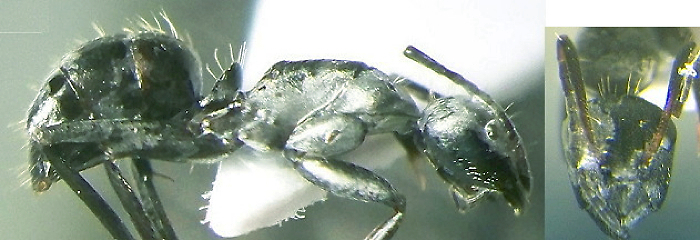 Gaster and lower
legs brown or black brown; major TL
7.5-8.0 mm Gaster and lower
legs brown or black brown; major TL
7.5-8.0 mm |
Angola & Gabon - olivieri |
| -- | Part of alitrunk and base of gaster brown | East Africa - olivieri ssp moshianus |
| -- |  Gaster black, size
larger - Congo Gaster black, size
larger - Congo |
olivieri ssp sorptus |
| 31 | Erect pilosity on gaster as fine as the pubescence | olivieri ssp tenuipilis |
| -- | Erect pilosity on gaster more slender than pubescence | 32 |
| 32 | 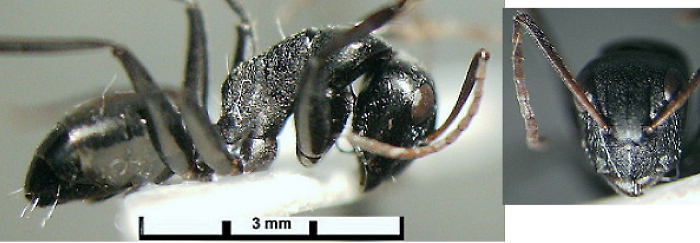 Overall shinier, with
sparse pilosity, gaster with very
sparse pubescence; translucent and short; propodeal angle very marked Overall shinier, with
sparse pilosity, gaster with very
sparse pubescence; translucent and short; propodeal angle very marked |
Angola & Gabon - olivieri ssp lemma |
| -- | Pubescence on gaster denser | 33 |
| 33 | More robust, scale blunter, lower legs black, pubescence yellowish | Mozambique, Delagoa - olivieri ssp delagoensis |
| -- | More narrow, scale sharper; lower legs brown, pubescence white | 34 |
| 34 | 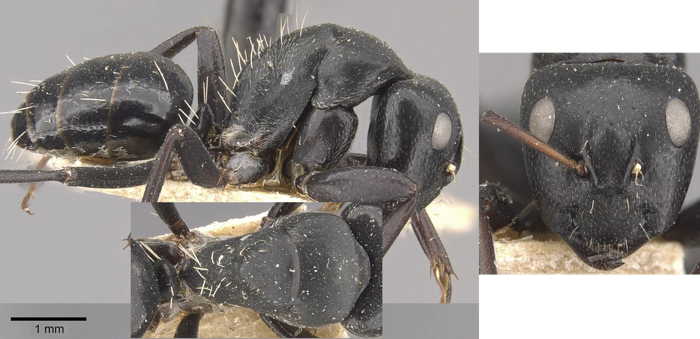 Erect
pilosity blunt and slender; TL 4.3-6.0 mm Erect
pilosity blunt and slender; TL 4.3-6.0 mm |
. |
| . | 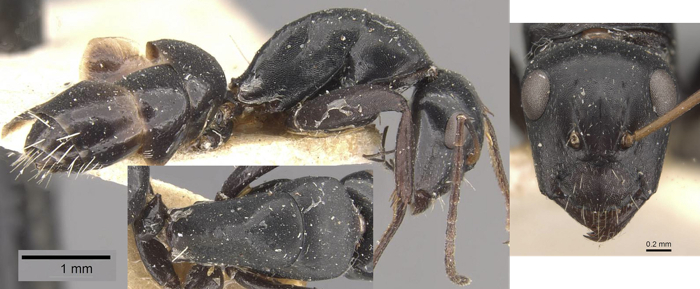 Minor Minor |
Mozambique, Delagoa - tauricollis |
| -- | Erect pilosity fine and sharp | Cameroun - olivieri ssp pax |
| 35 |
Alitrunk short, vaulted, propodeum rounded; gaster very shiny; pubescence short, translucent, lower legs black | South Africa - olivieri ssp infelix |
| -- |  Alitrunk elongated,
slightly convex; propodeum rounded;
gaster shiny; lower leg rust coloured Alitrunk elongated,
slightly convex; propodeum rounded;
gaster shiny; lower leg rust coloured |
Aldabra - olivieri ssp freyeri |
| Head and alitrunk other than black | -- | |
| 36 | Promesonotum strongly convex and raised higher than propodeum; latter with a flat dorsum | 37 |
| -- | Promesonotum no more than slightly higher than propodeum | 38 |
| 37 |  TL
4.2-4.7 mm; generally brown-red, with darker areas TL
4.2-4.7 mm; generally brown-red, with darker areas |
Ethiopia, Senegal - ilgii |
| -- | 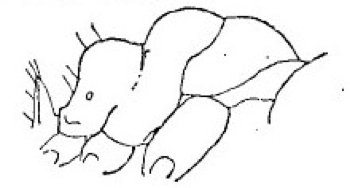 TL ca 6 mm;
ferruginous-yellow, upper head and propodeum
brownish TL ca 6 mm;
ferruginous-yellow, upper head and propodeum
brownish |
. |
| . | 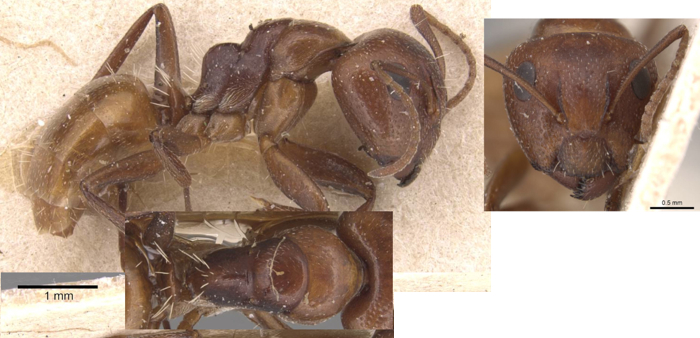 |
Ethiopia & Sudan - diplopunctatus |
| 38 |  Head as
narrow as the alitrunk; notably longer than wide; alitrunk and gaster
elongated, yellow; TL 4.5-7.5 mm Head as
narrow as the alitrunk; notably longer than wide; alitrunk and gaster
elongated, yellow; TL 4.5-7.5 mm |
Somalia - bottegoi |
| -- | Head wider than alitrunk, more robust | 39 - robecchii and ssps. |
| 39 | Propodeum "tectiforme", slightly lower than pronotum | 40 |
| -- | Alitrunk profile feebly convex, no break at metanotal groove | 41 |
| 40 | 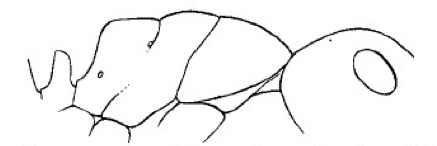 Propodeum angular;
colour dark brown red; posterior third
of gaster and sides of alitrunk blackish; femora and antennae yellow
red; TL 4-5.8 mm Propodeum angular;
colour dark brown red; posterior third
of gaster and sides of alitrunk blackish; femora and antennae yellow
red; TL 4-5.8 mm |
. |
| . | 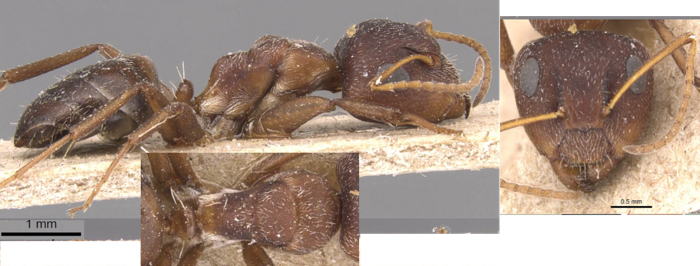 |
Somalia & Tanzania - robecchii |
| -- | Propodeum rounded, colour red yellow, gaster black | Zimbabwe - robecchii ssp rhodesiana |
| 41 | 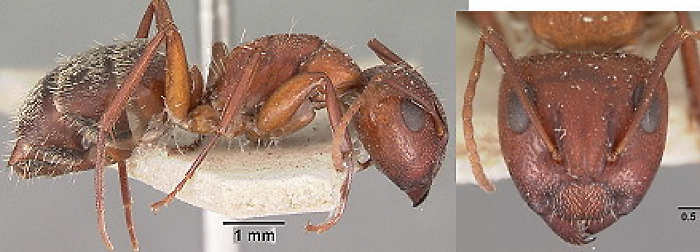 Colour
reddish, base of gaster yellow, posterior of gaster black brown; major
TL 7-9 mm Colour
reddish, base of gaster yellow, posterior of gaster black brown; major
TL 7-9 mm |
East Africa & Indian Ocean Is - troglodytes |
| -- | Colour reddish, each gastral segment with brown border [note: this seems to be wrongly given as ssp of foraminosus in Bolton (1995)] | Angola - troglodytes ssp cuitensis |
| -- | Gaster entirely yellow red in female | Ethiopia - troglodytes ssp abyssinica |
| Tibiae prismatic or generally channelled; scapes always flattened | -- | |
| 42 | Propodeum without tubercles | 43 |
| -- |  Propodeum bituberculate;
TL 9.0 mm; matt black, extremities reddish Propodeum bituberculate;
TL 9.0 mm; matt black, extremities reddish |
West Africa - bituberculatus |
| 43 | Scape dilated, but the apex less than four times as wide as the base | 44 |
| -- | 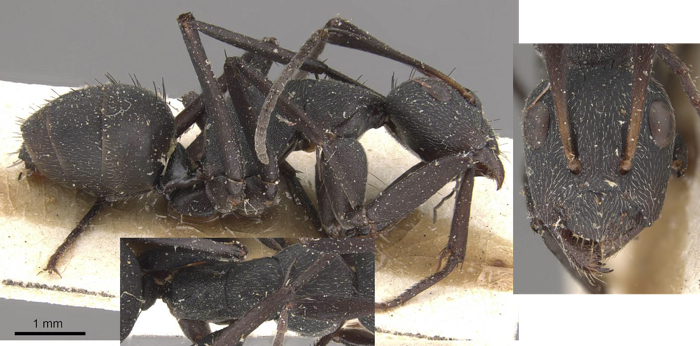 Scape foliate, apex
expanded to four times the basal width; TL 8 mm; colour as bituberculatus
but whole of mandibles and base of scape reddish Scape foliate, apex
expanded to four times the basal width; TL 8 mm; colour as bituberculatus
but whole of mandibles and base of scape reddish |
West Africa - compressiscapus |
| 44 | Clypeus of major and minors near trapezoidal [NOTE the image in Wheeler (1922) of perrisii jucundus shows the clypeus as trapezoidal - may be the original key has the numbers transposed!] | 44 |
| -- | Clypeus of major near rectangular | 46 |
| 45 |  Major
with distinct pits on genae; pubescence sparse but distinctly
yellowish, erect hairs numerous, quite long and yellowish (type minor
shown here) Major
with distinct pits on genae; pubescence sparse but distinctly
yellowish, erect hairs numerous, quite long and yellowish (type minor
shown here) |
East Africa - puberulus |
| -- |  Major
with only indistinct pits on genae; TL 6.0 mm; matt, black, with
extremities of tarsi and mandibles reddish Major
with only indistinct pits on genae; TL 6.0 mm; matt, black, with
extremities of tarsi and mandibles reddish |
. |
| . | 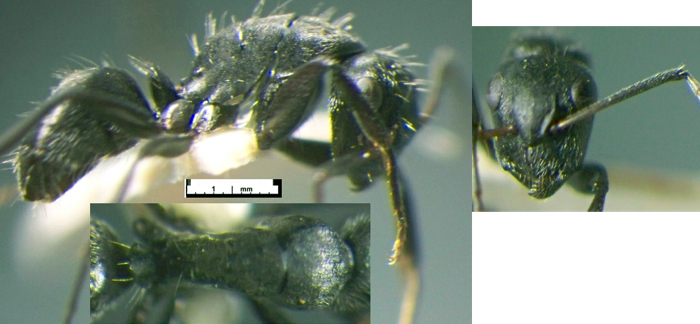 Minor Minor |
western Africa - bayeri |
| 46 | Erect hairs translucent brown or blackish | 47 |
| -- | Erect hairs clear, white or yellowish | 48 |
| 47 | 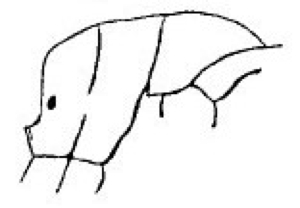 Pubescence
very sparse, and extremely short; TL 6.3-7.0
mm; black, opaque and densely punctate Pubescence
very sparse, and extremely short; TL 6.3-7.0
mm; black, opaque and densely punctate |
eastern Africa - carbo |
| -- | 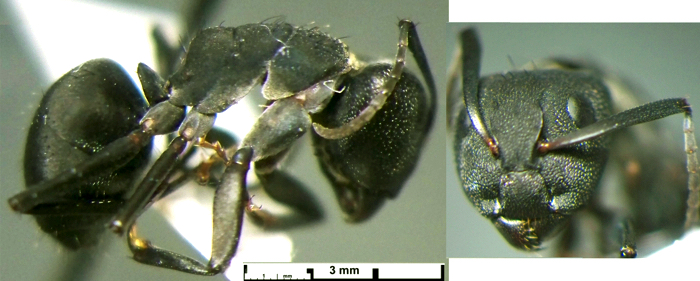 Pubescence short but
distinct; TL 7.4-10 mm Pubescence short but
distinct; TL 7.4-10 mm |
western Africa - carbo ssp occidentalis |
| 48 | 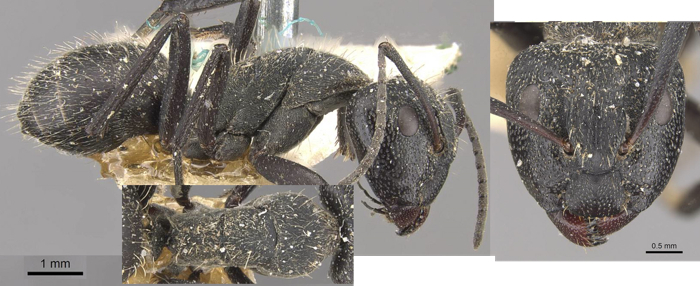 Major, tibiae
only feebly prismatic, with slight channeling; TL 8.0 mm; matt black Major, tibiae
only feebly prismatic, with slight channeling; TL 8.0 mm; matt black |
. |
| . | 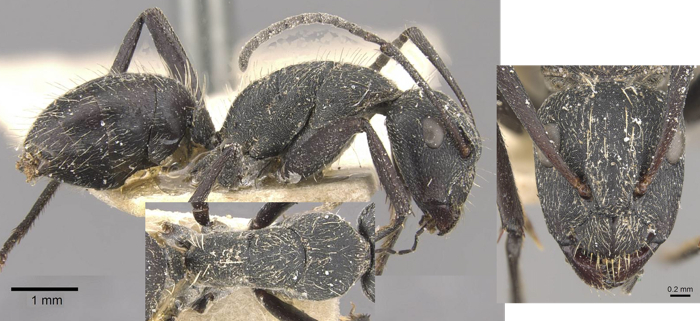 Minor Minor |
Angola, Benguela, Cameroun - crucheti |
| -- | Tibiae with distinct channeled and prismatic tibiae; all generally black amd matt; base of scape and apex of mandibles reddish | 49 - perrisii and ssps |
| 49 | Propodeum with rounded angle | 50 |
| -- | Propodeum with well marked but slightly diffuse angle | 51 |
| 50 | 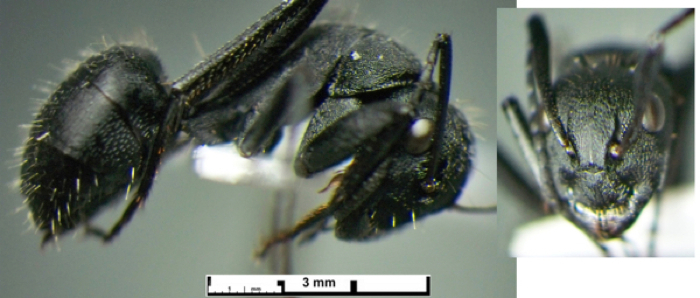 Scape
surpassing occipitum by more than its width in major; tibial channeling
less pronounced; TL 10-11 mm; with whitish erect hairs Scape
surpassing occipitum by more than its width in major; tibial channeling
less pronounced; TL 10-11 mm; with whitish erect hairs |
Angola - perrisii |
| -- | Scape longer; tibiae strongly channelled; longer, TL 12 mm | western Africa - perrisii ssp. nigeriensis |
| 51 | 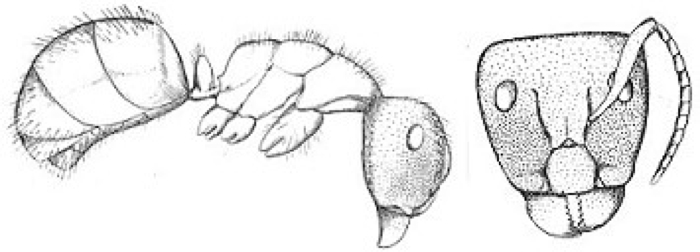 Gaster covered with
quite dense yellow pubescence; TL
10-11 mm Gaster covered with
quite dense yellow pubescence; TL
10-11 mm |
Congo - perrisii ssp. jucundus |
| -- | Gaster with shorter, more spaced out, whitish pubescence; shorter | Congo - perrisii ssp. grandior |
| Genus page |
© 2007, 2008, 2009, 2010, 2011, 2013, 2014 - Brian
Taylor
CBiol
FSB FRES 11, Grazingfield, Wilford, Nottingham, NG11 7FN, U.K. |
href="myrmotrema.htm"